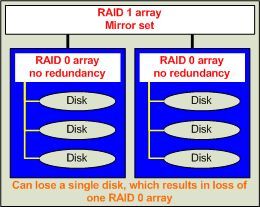Get the basics on multilevel RAID sets

While these RAID levels can provide a great level of redundancy, and it might not seem like there's a need for other levels, a number of additional levels have been created to address other redundancy concerns. These multilevel RAID sets are fairly standard and widely used. In my next article, I will talk about some other, less common RAID levels that you may run across.
RAID 0+1 (Mirror of Stripes, RAID 01, or RAID 0 then RAID 1)
- Drives required (minimum): 4 (requires an even number of disks)
- Max capacity: Number of disks x Disk capacity / 2
- Description: RAID 0+1 is a mirror (RAID 1) of a stripe set (RAID 0). For example, suppose you have six hard disks. To create a RAID 0+1 scenario, you would take three of the disks and create a RAID 0 stripe set with a total capacity of three times the size of each disk (number of disks x capacity of disks). Now, to the other three disks, you would mirror the contents of this stripe set.
- Pros: A RAID 0+1 set could theoretically withstand the loss of all of the drives in one of the RAID 0 arrays and remain functional since all of the data would be mirrored to the second RAID 1 array. In most cases, the failure of two drives will compromise the array since many RAID controllers will take one of the RAID 0 mirrors offline if one of the disks in the RAID set fails (after all, a RAID 0 array does not provide any kind of redundancy), thus, leaving just the other RAID 0 set active, which has no redundancy. In short, a total array failure requires the loss of a single drive from each RAID 0 set. Provides very good sequential and random read and write performance.
- Cons: Requires 50% of the total disk capacity to operate. Not as fault-tolerant as RAID 10. Can withstand loss of only a single drive with most controllers. Scalability is limited and expensive.
Notes: Please take note of the RAID 0 then RAID 1 notation above. This is exactly how the RAID set is created and is an important differentiator with RAID 10.
Figure A |
 |
RAID 10 (Stripe of Mirrors, RAID 1+0, or RAID 1 then RAID 0)
- Drives required (minimum): 4 (requires an even number of disks)
- Max capacity: Number of disks x Disk capacity / 2
- Description: RAID 10 is a stripe (RAID 0) of multiple mirror sets (RAID 1). Again, suppose you have six hard disks. To create a RAID 10 array, take two of the disks and create a RAID 1 mirror set with a total capacity of one disk in the array. Repeat the same procedure twice for the other four disks. Finally, create a RAID 0 array that houses each of these mirror sets.
- Pros: A RAID 10 set can withstand the loss of one disk in every RAID 1 array, but cannot withstand the loss of both disks in one RAID 1 array. As with RAID 0+1, RAID 10 provides very good sequential and random read and write performance. These multilevel RAID arrays can often perform better than their single-digit counterparts due to the ability to read from and write to multiple disks at once.
- Cons: Requires 50% of the total disk capacity to operate. Scalability is limited and expensive.
Notes: Again, take note of the RAID 1 then RAID 0 notation.
Figure B |
RAID 50 (Stripe of Parity Set, RAID 5+0, or RAID 5 then RAID 0)
- Drives required (minimum): 6
- Max capacity: (Drives in each RAID 5 set – 1) x Number of RAID 5 sets x Disk capacity
- Description: RAID 50 is a stripe (RAID 0) of multiple parity sets (RAID 5). This time, suppose you have twelve hard disks. To create a RAID 50 array, take four of the disks and create a RAID 5 stripe with parity set with a total capacity of three times the size of each disk (remember, in RAID 5, you "lose" one disk's worth of capacity). Repeat the same procedure twice for the other eight disks. Finally, create a RAID 0 array that houses each of these RAID 5 sets.
- Pros: A RAID 50 set can withstand the loss of one disk in every RAID 5 array, but cannot withstand the loss of multiple disks in one of the RAID 5 arrays. RAID 50 provides good sequential and random read and write performance. These multilevel RAID arrays can often perform better than their single-digit counterparts due to the ability to read from and write to multiple disks at once.
- Cons: RAID 50 is somewhat complex and can be expensive to implement. A rebuild after a drive failure can seriously hamper overall array performance.
Figure C |